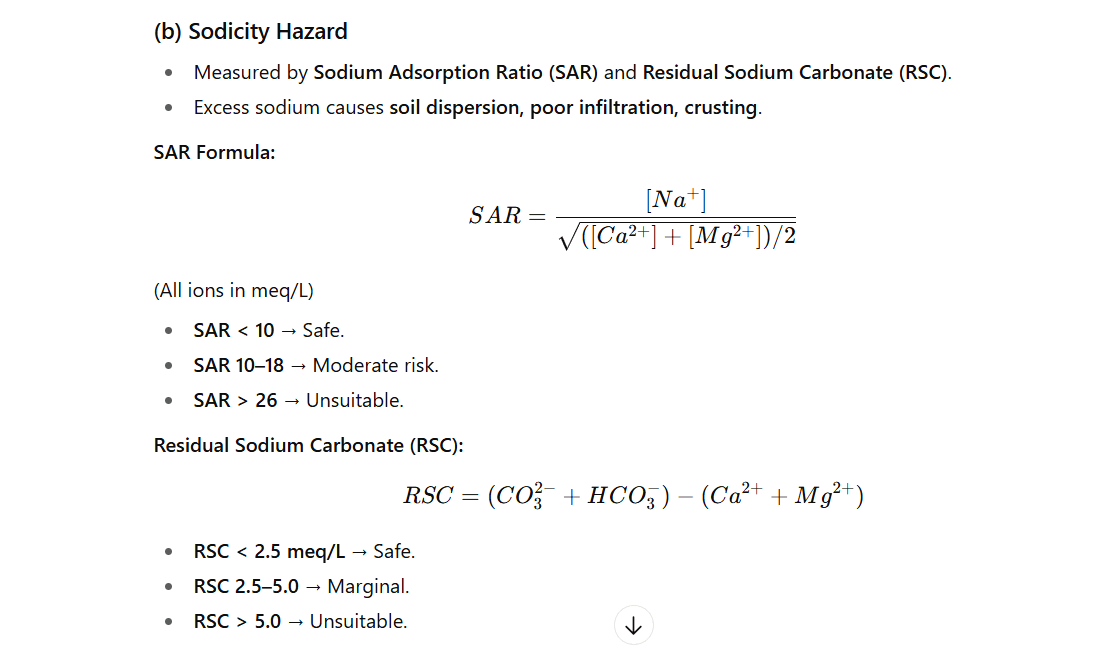Water Quality in Agriculture
Water quality refers to the chemical, physical, and biological properties of irrigation water that affect soil health, crop growth, and productivity. Poor-quality water can lead to salinity, sodicity, toxicity, or health hazards.
Parameters of Irrigation Water Quality
(a) Salinity Hazard
- Measured by Electrical Conductivity (EC) of water (dS/m).
- High salt content reduces osmotic potential, affecting plant water uptake.
|
Water Class |
EC (dS/m) |
Suitability |
|
Low salinity |
< 0.75 |
Suitable for all crops, soils |
|
Medium |
0.75 – 3.0 |
Suitable for moderate salt-tolerant crops |
|
High |
3.0 – 7.5 |
Suitable only for salt-tolerant crops (barley, cotton, sorghum) |
|
Very high |
> 7.5 |
Not suitable without management |
(b) Sodicity Hazard

(c) Specific Ion Toxicities
- Chloride (Cl⁻) – > 4 meq/L toxic to sensitive crops (beans, citrus).
- Boron (B) – essential micronutrient, but toxic > 2 ppm for sensitive crops.
- Sulfates (SO₄²⁻) – usually safe, but excessive → salinity.
(d) pH of Irrigation Water
- Normal range: 6.5 – 8.5.
- Alkaline water (pH > 8.5) → usually sodic, poor infiltration.
- Acidic water (pH < 6.0) → may contain toxic metals (Fe, Mn, Al).
(e) Other Parameters
- Total Dissolved Solids (TDS) – < 450 ppm safe, > 2000 ppm unsafe.
- Biological quality – wastewater/effluent irrigation may contain pathogens (E. coli).
Classification of Irrigation Water (USSL, 1954)
- Based on EC and SAR, irrigation water is classified into 16 classes (C1S1 to C4S4).
|
Salinity Class |
EC (dS/m) |
Sodium Class |
SAR |
|
C1 = Low |
< 0.25 |
S1 = Low |
< 10 |
|
C2 = Medium |
0.25–0.75 |
S2 = Medium |
10–18 |
|
C3 = High |
0.75–2.25 |
S3 = High |
18–26 |
|
C4 = Very high |
> 2.25 |
S4 = Very high |
> 26 |
Example: C2S1 water → Medium salinity, low sodicity (generally suitable).
Management of Poor-Quality Water
(a) Saline Water (High EC)
- Grow salt-tolerant crops (barley, cotton, sorghum).
- Provide good drainage.
- Leaching requirement (LR): apply extra water to flush salts below root zone.
(b) Sodic Water (High SAR/RSC)
- Gypsum application – provides Ca²⁺ to replace Na⁺.
- Use organic manures / green manures to improve soil structure.
- Conjunctive use – blend sodic water with canal water.
(c) Alkaline Water (High pH)
- Apply acid-forming fertilizers (ammonium sulfate).
- Add sulfur or sulfuric acid to neutralize alkalinity.
(d) Wastewater / Effluents
- Pre-treatment (settling, filtration).
- Restricted to non-edible crops or trees.
- Long-term use may cause heavy metal accumulation.
Crop Tolerance to Salinity
|
Tolerance |
EC Threshold (dS/m) |
Crops |
|
Sensitive |
< 2 |
Beans, citrus, onion, carrot |
|
Moderately sensitive |
2–4 |
Wheat, maize, soybean, groundnut |
|
Moderately tolerant |
4–6 |
Sorghum, sunflower, rice |
|
Tolerant |
6–10 |
Cotton, barley, sugar beet |
Standards (India)
- BIS (Bureau of Indian Standards) – irrigation water EC < 2.25 dS/m generally safe.
- FAO Guidelines (Ayers & Westcot, 1985) – widely used globally for assessing irrigation water quality.
Conclusion
- Water quality is as important as water quantity.
- Parameters: EC (salinity), SAR & RSC (sodicity), pH, toxic ions.
- Poor-quality water can still be used with proper management (gypsum, leaching, blending, tolerant crops).
- Future: focus on monitoring, treatment, and conjunctive use for sustainable irrigation.

